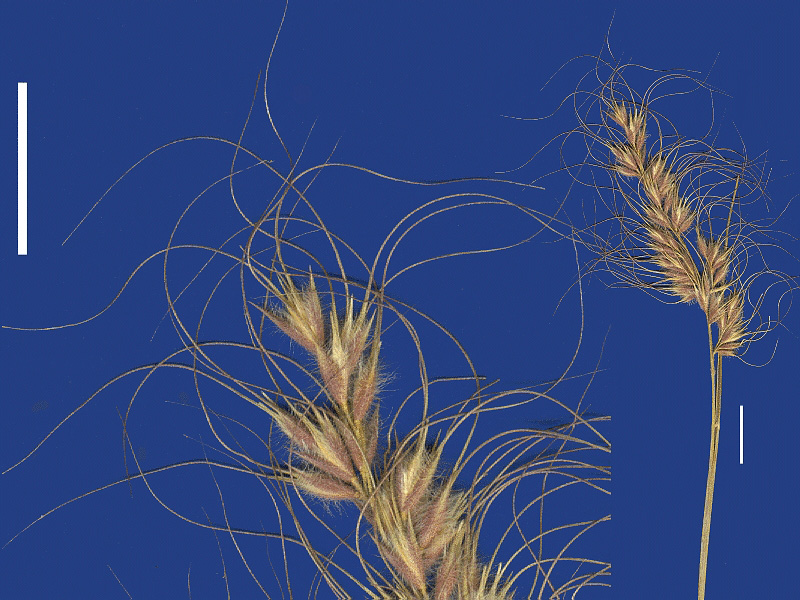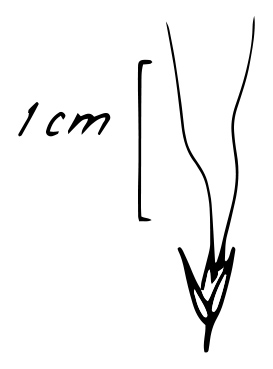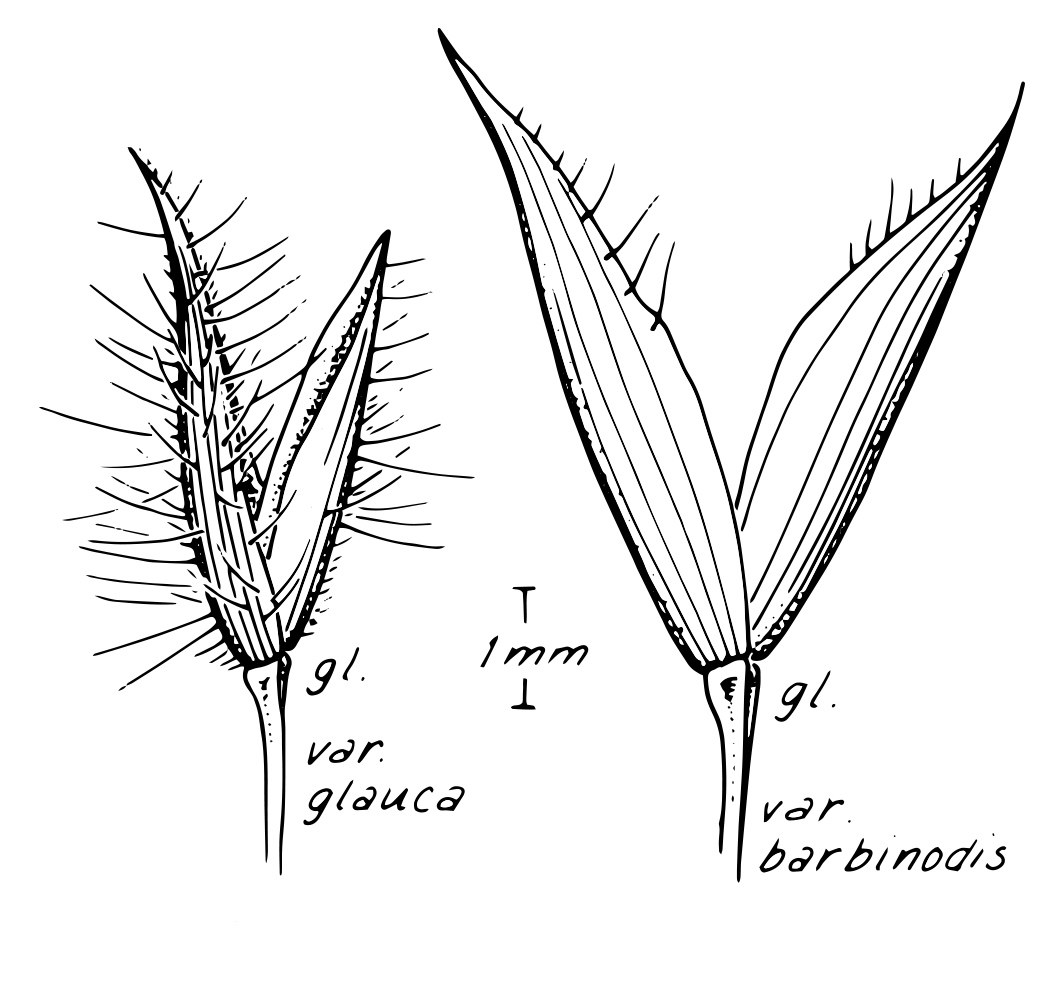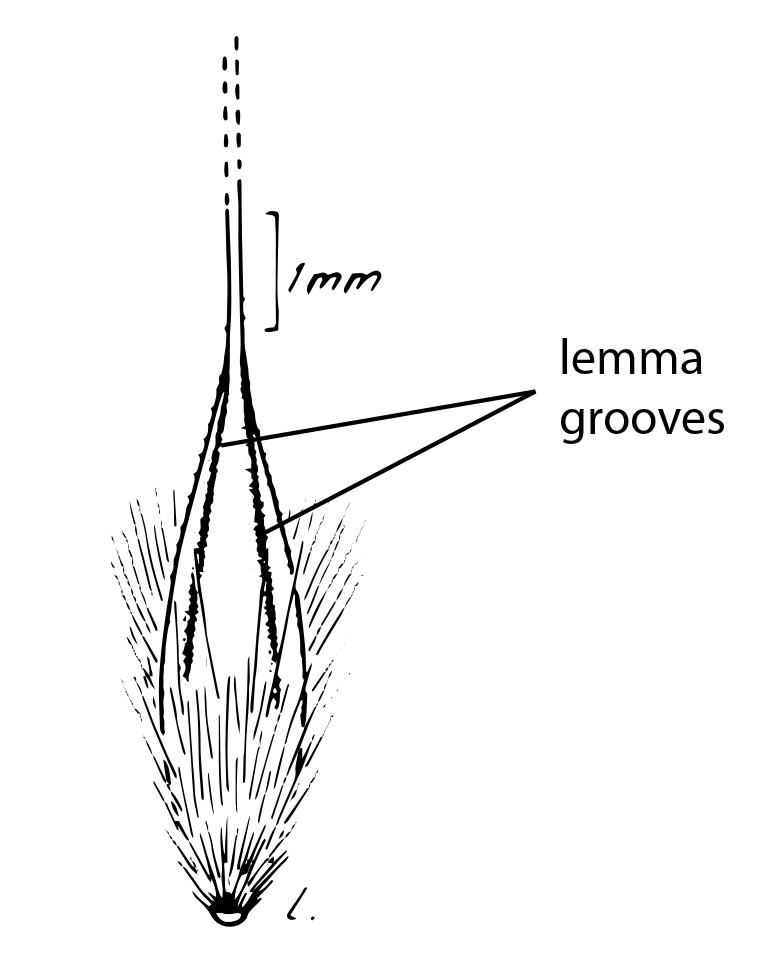Eriachne glauca
R.Br.
Pan Wanderrie grass
This species occurs in Cape York Peninsula as a perennial from 45-120 cm high. Stems, stem joints and foliage are usually hairless and often blue-green with whitish bloom (pruinose) or purple. Leaves are cauline (arising along the stem) and leaf blades are densely covered above with small bladder like sacs, however, sacs are only visible with a microscope. Leaf blades are up to 25 cm long and 5 mm wide, and rough to the touch on blade margins. Inflorescences or flowering branches terminate the stem and are exserted from leaf axils. The inflorescences or flowering branches are contracted and dense panicles, rarely open, with branches arising along a central stem, panicles are 3-14 cm long, 1.5-5 cm wide (Fig. 1). Eriachne glauca has spikelets (the basic flowering unit) consisting of two glumes encompassing two bisexual florets (modified flowers) (Fig. 3a & b). The florets are subequal or slightly shorter than the glumes (sometimes the palea exceeding glumes by c. 1 mm), the lemma of each floret giving rise to a curved awn 7-25 mm long (Fig. 2). The palea of each floret is tapered to a point and notched or split for up to 0.5 mm at apex.
Botanical Description
A perennial species 45-95 (-120) cm high. The culms and foliage are often pruinose or purple with culm nodes glabrous or rarely bearded. Leaves with upper surface densely vesicular, blade to 25 cm long and up to 5 mm wide, involute and stiff, and finely pointed. The inflorescences are contracted dense panicles, rarely open, 3-8.5(-14) cm long, 1.5-3(-5) cm wide (Fig. 1). Spikelets are defined by two glumes (3-)4-5.8(-7) mm long, tapered to point or with awnlet to 1.5 mm long (Fig. 2 & 3a). The glumes encompass two bisexual florets, the florets subequal or slightly shorter than the glumes, the lemma (2.8-)4-5.5 mm long. The lemma of each floret is awned, the lemma awn 7-15(-25) mm long, with the palea of each floret tapered into a beak usually notched or split for up to 0.5 mm long. The lemma is hairy in lower 1/3-1/2 with hairs not exceeding apex and with two grooves present (Fig. 3b).
Diagnostic Features
Eriachne glauca is one of many species of Eriachne characterised by long awned spikelets, the awns curled, curved or bent. Other long awned species of Eriachne which occur in the region and may be easily confused with this species are E. armittii, E. burkittii, E. squarrosa, E. stipacea and E. rara. Some of these species are more easily distinguished than others. Most are treated in this guide, however some of the key differences between the species are shown in Table 1. In other regions of Australia e.g. the Northern Territory, additional species may also need to be considered. Eriachne glauca is distinguished by the combination of the following characters, leafy herbaceous habit, pruinosity, a dense covering of bladder like sacs on the upper surface, grooves present on lemma and the tapered or notched palea. Users are encouraged to consult Lazarides (2005) or Simon & Alfonso (2011) for more detail on distinguishing between these species.
Natural Values
This species is likely to provide seed for granivorous or seed eating animals.
Habitat
This species occurs north of 20°S across northern Australia. Two varieties are recognised with Eriachne glauca var. glauca the more common plant distinguished by glabrous stem nodes. It is found in seasonally flooded habitats including flood plains, levees, banks of watercourses, swamps, lagoons, depressions, claypans and seepage areas (Lazarides 2005, Simon 2011).
Land Management Notes
Species of this genus are considered generally to be of low forage value (Lazarides 2002).




Resources
AVH (2017) Australia’s Virtual Herbarium, Council of Heads of Australasian Herbaria, <http://avh.chah.org.au>, accessed 30 May 2017.
Lazarides, M. (1995) The genus Eriachne (Eriachneae, Poaceae). Australian Systematic Botany 8(3): 355-452.
Lazarides, M. (2002) Economic attributes of Australian grasses. Flora of Australia 43: 213-245.
Lazarides, M., Weiller, C.M. & McCusker, A. in Mallett, K. (ed.) (2005) Eriachne. Flora of Australia 44B: 132-175.
Simon, B.K. & Alfonso, Y. (2011) AusGrass2, http://ausgrass2.myspecies.info/accessed on [20 March 2017].

